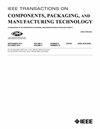Machine Learning-Based Diagnosis of Defects in 2.5-D and 3-D Interconnects
IF 3
3区 工程技术
Q2 ENGINEERING, ELECTRICAL & ELECTRONIC
IEEE Transactions on Components, Packaging and Manufacturing Technology
Pub Date : 2025-03-11
DOI:10.1109/TCPMT.2025.3550201
引用次数: 0
Abstract
Diagnosing interconnect line defects becomes increasingly challenging in advanced chiplet integration due to the immaturity of fabrication processes, reduced interconnect spacing, and increased density. In this article, a nondestructive interconnect defect diagnosis method is proposed. First, redistribution layers (RDLs) on the 2.5-D silicon interposer and 3-D through silicon via-RDL (TSV-RDL) interconnect channels are simulated by ANSYS HFSS, with open and short defects injected at various positions to analyze signal integrity; utilizing基于机器学习的2.5-D和3d互连缺陷诊断
由于制造工艺的不成熟、互连间距的减小和密度的增加,在先进的芯片集成中,互连线缺陷的诊断变得越来越具有挑战性。本文提出了一种无损互连缺陷诊断方法。首先,利用ANSYS HFSS对2.5维硅中间层和3维通硅孔- rdl (TSV-RDL)互连通道上的重分布层(rdl)进行仿真,在不同位置注入开放缺陷和短缺陷,分析信号完整性;利用S参数和群延迟时间(GDT)作为特征向量,专门采用机器学习算法对缺陷进行分类和识别。在缺陷定位方面,提出了一种基于自适应回归和聚类驱动的高精度缺陷定位方案,实现了高精度、可靠的缺陷定位。结果表明,该算法能准确地识别出开放缺陷和短缺陷。在缺陷定位中,该方法的平均相对误差(MRE)小于8%,最大相对误差(MaxRE)不超过13%。与相关算法相比,定位精度显著提高,为封装互连线缺陷的识别和定位提供了新的视角。
本文章由计算机程序翻译,如有差异,请以英文原文为准。
求助全文
约1分钟内获得全文
求助全文
来源期刊

IEEE Transactions on Components, Packaging and Manufacturing Technology
ENGINEERING, MANUFACTURING-ENGINEERING, ELECTRICAL & ELECTRONIC
CiteScore
4.70
自引率
13.60%
发文量
203
审稿时长
3 months
期刊介绍:
IEEE Transactions on Components, Packaging, and Manufacturing Technology publishes research and application articles on modeling, design, building blocks, technical infrastructure, and analysis underpinning electronic, photonic and MEMS packaging, in addition to new developments in passive components, electrical contacts and connectors, thermal management, and device reliability; as well as the manufacture of electronics parts and assemblies, with broad coverage of design, factory modeling, assembly methods, quality, product robustness, and design-for-environment.
 求助内容:
求助内容: 应助结果提醒方式:
应助结果提醒方式:


